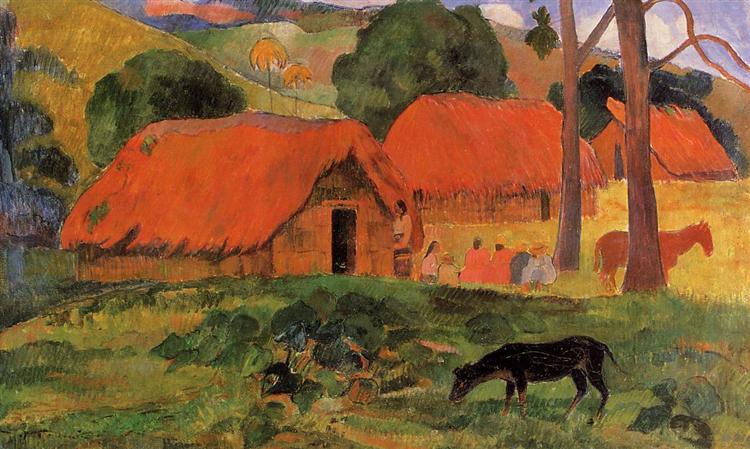Kuvaus
Paul Gauguin's painting The Three Huts (1891) encapsulates an aesthetic quest deeply linked to the exploration of cultural identity and man's relationship with his environment. Painted during his stay in Tahiti, this work is a testament to Gauguin's interest in primitive life and his desire to escape Western civilization, which he perceived as decadent. In this context, The Three Huts is not just a depiction of a landscape, but a meditation on simplicity, isolation and the values of a life more connected to nature.
In the composition, three huts stand in the foreground, arranged in a triangular pattern that draws the viewer's gaze across the painting. The structures, built with thatched roofs and warm brown walls, are surrounded by a lush landscape, full of tropical vegetation that reinforces the feeling of isolation in a natural environment. This architectural element is completely integrated into its context, and could be interpreted as a metaphor for the life that Gauguin himself longed for, that return to the primordial.
Color and form are essential components in this work. Gauguin uses a palette of saturated colors that convey emotion and warmth. The vibrant greens of the vegetation contrast with the earthy tones of the huts. The blue haze that seems to envelop the scene suggests the warm and peaceful climate of Tahiti, but at the same time provokes a sense of mystery. This use of color is characteristic of Gauguin's synthetic style, which sought not only to represent reality, but also to account for his personal interpretation of it. His technique of applying color in bold, flat strokes, almost in a mosaic-like fashion, seeks to highlight the emotional and spiritual intensity of the scene.
In “The Three Huts,” the absence of human figures resonates with the atmosphere of abandonment and tranquility. While Gauguin often incorporated characters into his works, the silence surrounding the huts suggests a meditation on solitude, connection to place, and introspection. The simplicity of the architectural structures may indicate a desire to live outside of what he considered the artificial complexities of modern society.
This work is part of a body of work that Gauguin produced during his first stay in Polynesia, a crucial period where he developed his personal style by incorporating influences from local art and his own unique vision. Comparisons with other artists of his time, such as Vincent van Gogh or Henri Toulouse-Lautrec, reveal a divergence in approach to symbolism and emotional expression; while Van Gogh exploited the intensity of colour to express his longing and despair, Gauguin seeks a more spiritual development and a connection to the primordial.
The cultural influences of the island are also evident in the symbolism present in his work. Although The Three Huts focuses on a more everyday and less mystical aspect, the sense of belonging and the desire to understand and embrace the "primitive" resonate throughout the Post-Impressionist aesthetic that Gauguin promoted throughout his career. In a world that seems to be in conflict between modernity and tradition, this painting is a reflection of his desire to discover a more authentic way of life through the simplicity of the rural environment.
"The Three Huts" stands as a milestone not only in Gauguin's output, but in the evolution of modern art, inviting the viewer to reflect on the complexity of isolation and the search for meaning in an increasingly tumultuous world. Through an approach that transcends mere representation, the work encapsulates a personal and cultural quest that continues to resonate today.
KUADROS ©, a famous painting on your wall.
Hand-made oil painting reproductions, with the quality of professional artists and the distinctive seal of KUADROS ©.
Painting reproduction service with satisfaction guarantee. If you are not completely satisfied with the replica of your painting, we will refund 100% of your money.

